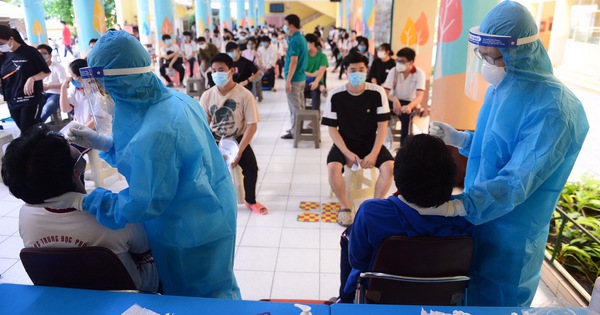
Medical staff take samples to test for COVID-19 for candidates taking high school graduation exams in Ho Chi Minh City on the morning of July 3 – Photo: QUANG DINH
Tech4Covid is one of two research groups provided with data by Ho Chi Minh City’s Department of Information and Communications to analyze, evaluate, forecast and synthesize solutions to the COVID-19 pandemic in Ho Chi Minh City.
share with youth online, Dr. Dinh Ba Tien – Dean of the Faculty of Information Technology, University of Natural Sciences (National University of Ho Chi Minh City), leader of the research team – said:
– When the COVID-19 pandemic broke out in the fourth wave in Ho Chi Minh City in early June 2021, Tech4Covid was founded, calling on friends and technology students to join together to help build something for the future Can you City by their knowledge and expertise.
The current members are about 70 people, including scientists and lecturers from the Faculty of Information Technology at universities in Vietnam and the US; experts in data analysis, technology experts of the world’s large corporations; Project Managers, IT Engineers with many years of experience … come from Vietnam businesses and are volunteer students from the Information Technology departments of universities.
All members personally and voluntarily participate in the work.
* When did Tech4Covid receive data from the Ho Chi Minh City Department of Information and Communications and start analyzing, evaluating and forecasting the COVID-19 pandemic in Ho Chi Minh City, sir?
– We started modeling and analyzing data on COVID-19 around the third week of June 2021. The data obtained by the group includes information on COVID-19 in Ho Chi Minh City from May 27 to the present.
* How did the team summarize and analyze the data to assess translation trends?
– after getting data, Group registered F0 cases for screening with symptoms (cough, fever…), Number of F0 cases detected in the community and in isolation and blockade areas during the day… Number identified. Characteristics that closely reflect the epidemiological trends/risks of the city and each district.
The model is based on the same analysis method that author Kwok Tran, an expert in analyzing COVID-19 data in the US and the world since the outbreak began in March 2020, sends weekly reports to the CDC forecast group in the US, which is based on the data. is based. of daily deaths.
Since the number of deaths in HCMC is still low, the group used the number of symptomatic screened cases – which is HCMC-specific data.
* What did the research team find through data analysis?
– With the same social distancing policy, the logarithm of the number of symptomatic infections tested in the community is a straight line, the so-called “route of transmission”. This path of transition changed 11 days after the implementation of the new policy. Day 11 is the number of days from the onset of infection to the time when there are obvious symptoms to go to the hospital for testing.
After Ho Chi Minh City implemented Directive 15 and Directive 16 (applicable to the entire Go Wap District and Than Lok Ward, District 12) on June 1, the transition route turned in a good direction (slow growth) but down did not go.
The transition coefficient (R0) has been reduced from 1.22 to 1.06. However, after that, this coefficient is still greater than 1.0, which means that the trend is still up. Therefore, the city continues to implement Directive 10 to make it more stringent in order to mitigate the trend of the pandemic.
This model was used to evaluate the effect of indicators to help slow the epidemic down (11 days after application – corresponding to the number of incubation days of infection to the day of symptoms – world statistics on the basis of). gender).
* With the current complex situation of the COVID-19 pandemic, in your opinion, what solutions should Ho Chi Minh City implement in order to quickly control the disease? What were the specific recommendations of the group?
Some of the group’s recommendations were forwarded to the Department of Information and Communications and Ho Chi Minh City leaders. In particular: continue to mobilize people to seriously implement Directives 10 and 5K to limit community transmission; soContinue to strengthen screening tests in the community (particularly applying information technology in classifying high-risk subjects in the same group F and supporting rapid and accurate tracing of related subjects). …); Advise people to take medical check-in announcement seriously, thereby helping to detect and localize quickly and effectively.
Our team also recommends improving QR code check-in technology and making the medical announcement process simpler and more efficient to help people trace and sort F1, F2… faster and more efficiently. be encouraged to declare and execute complete check-in for .
Also, it is recommended to implement electronic queuing and scheduling technology for testing and vaccination to reduce the risk of infection when gathering in large numbers.
According to the results of data analysis from May 27, Directive 15 and Directive 16 (applicable to Govap district and one ward 12 of the district) were effective on June 1, but were not strong enough to do so.
The effectiveness of Indicator 10 (effective from June 20) will be fully demonstrated on the model after 1 July and will be continued by the group to be monitored and analyzed in subsequent reports to assess the level of detailed efficiency. However, the trend shows that if we continue to follow directive 10 well, the pandemic will probably decrease in the near future.



